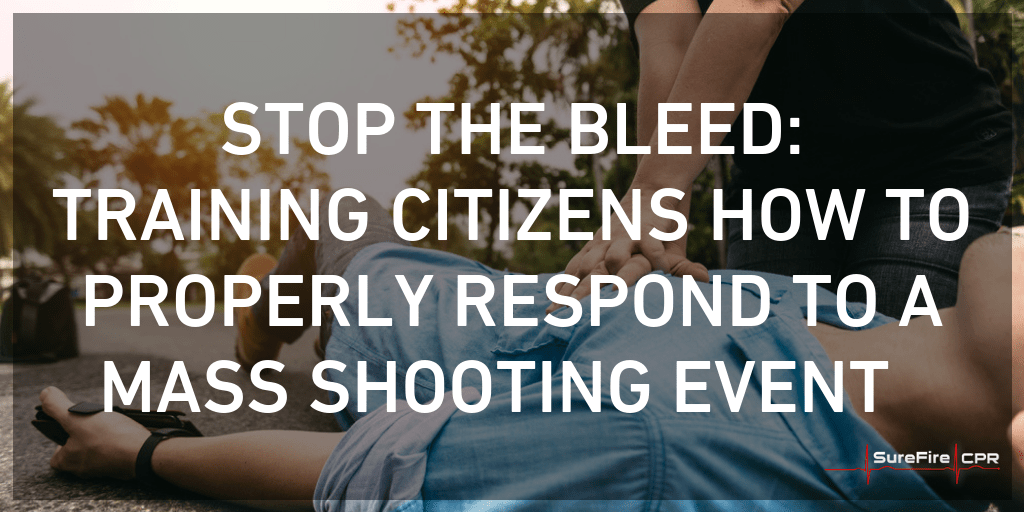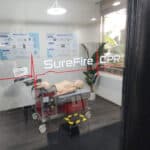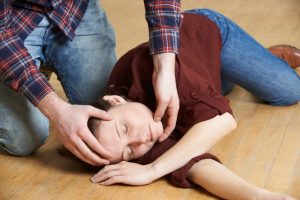Sadly, mass shootings don’t seem to be going away as America reaches its twentieth year of the twentieth century. On the contrary, mass shootings are getting more frequent and more deadly. As leaders and lawmakers are trying to figure out what to do on a national scale to curb the rise of school shootings and mass shootings, grassroots movements have started to help reduce the tragedy. Among these are Stop the Bleed, a government-backed initiative designed to help individuals learn proper emergency response protocol.
What is Stop the Bleed?
In 2015, The White House established a national awareness campaign called Stop the Bleed, designed to cultivate grassroots movements around the country that encourage bystanders to get trained, empowered and equipped to help in a bleeding-related emergency before paramedics and first responders get to the scene of the crime. The goal of the Stop the Bleed initiative is to train enough people around the country in BLS (Basic Life Support), CPR (Cardiopulmonary Resuscitation), Basic First Aid, and other lifesaving training courses.
No matter how fast first responders can get to the scene of a mass shooting, it still is not fast enough for many. A bleeding person can die within 5 minutes from blood loss if nothing is done to slow down or stop the bleeding.
A recent study done by the National Academies of Science has found that the leading cause of death in Americans under the age of 46 is trauma. Not only will Stop the Bleed training initiatives greatly help save as many lives as possible at a mass shooting, but they will be equipped to provide emergency response aid in other emergency situations. There are a number of traumatic events happening every day across the country—just look at the total number of auto fatalities that happen each day on our roadways around the country. Aid is needed nationwide on a daily basis, often in situations where first responders cannot arrive quickly enough to administer aid. If enough of people enroll in Stop the Bleed training, the number of trauma-related fatalities in the United States each year will reduce by a sizable margin.
Stop the Bleed Kits: Your Start to Emergency Response
Even with proper training, effective emergency response cannot be enacted without first aid supplies. Stop the Bleed offers an all-in-one kit to help individuals and organizations stay equipped. You can buy a Trauma and Bleeding Kit online from the Stop the Bleed Coalition for about 100 dollars. The four main things that the Trauma and Bleeding Kit contains that a traditional first aid kit doesn’t provide are a C-A-T tourniquet, Quikclot bleeding control dressing, 6-inch responder emergency dressing, and trauma shears. The Trauma and Bleeding Kit is small and lightweight so that you can easily keep it in your car or a backpack. If you do not have 100 dollars to spare, getting a mid-range first aid kit is a good alternate option, as it will have some dressing options as well as gloves to protect you from blood contamination.
Unsure if You Can be a Hero?
When it comes to Stop the Bleed, every little bit counts. If you are hesitant to get involved with the initiative because you are squeamish around blood, you should still consider getting CPR and First Aid training. You should also consider bringing a first aid kit when you go to large gatherings, either on your person or in your car. It’s amazing how quickly some people can get over their aversion to blood in an emergency when adrenaline takes over. But no amount of adrenaline can overcome a lack of training, which is why you should get CPR & First Aid certified to get prepared. At the very least, you can use your training to help administer preliminary aid before the ambulances and paramedics arrive. If it turns out that you can’t actually get over your fear of blood, providing a first aid kit to first responders can be just as helpful for saving lives.
If you are hesitant to get involved with Stop the Bleed because of a fear of contracting some sort of blood-bound disease, a Trauma and Bleeding Kit or a standard first aid kit (even a pocket-sized one) is your best friend. Both of these kits have gloves for you to put on before administering care. The Trauma and Bleeding Kit also provides you with a CPR Microshield mask so you can be protected from any airborne diseases. However, this protective gear is really an extra-safe precautionary measure. Even if you don’t have proper protective gear, the chances that you will contract a blood-born or air-born disease from a victim is very low.
The Difference Between Mass Shootings and Regular Shootings
Maybe you know a thing or two about guns and gunshot wounds. Maybe you are like most Americans and you know virtually nothing about either. You may have seen your fair share of violent movies and TV shows that feature people who have been shot getting driven to the hospital over extended periods of time. At the hospital, they’re rushed to the Emergency Room, operated on, and stitched up.
Real life is not like the movies, and AR-15’s (the most common type of weapon used in mass shootings) are not like most guns. AR-15 bullets differ from 9 mm bullets (the most common type of bullet used in guns, especially handguns) in that AR-15 bullets leave much larger holes as compared to the relatively small holes left by 9mm bullets. These larger holes cause victims to bleed out much faster than normal shooting occurrences. They are the primary difference between typical shootings and mass shootings, and they are the main reason why the Stop the Bleed initiative was started.
Enroll in These Types of Training to Help Stop the Bleed
The Stop the Bleed initiative was enacted to help people administer aid for injuries caused in mass shootings. To help Stop the Bleed, get equipped and get prepared. Once you have your kit, it’s time to learn how to use it. Here are a few courses you can take to learn how to administer emergency aid.
Cardiopulmonary Resuscitation (CPR)
Cardiopulmonary resuscitation — known more commonly as its abbreviation: CPR — is a technique used to preserve brain function during heart failure. CPR combines chest compressions often with artificial ventilation to restore spontaneous blood circulation and supply oxygen to the brain in the event of cardiac arrest. Today’s top CPR classes teach students how to administer CPR on individuals of all ages, how to assist choking victims, how to use an automated external defibrillator (AED), and other special considerations pertaining to cardiac arrest.
Basic First Aid
An essential for anyone who may encounter injuries, Basic First Aid teaches students how to provide initial care for non-cardiopulmonary injuries. Perhaps the most important class when it comes to preparation for mass shootings, Basic First Aid gives students comprehensive training in areas that include patient assessment, muscle and bone injuries, trauma (bleeding wounds), legal and emotional considerations, and more. In shooting situations, where trauma and bone injuries are common, learning Basic First Aid can make the difference between life and death.
Mass shootings are an unfortunate fact of life in the United States today. Get prepared by taking classes in Basic First Aid and CPR today. Our award-winning emergency response team here at SureFire CPR would be proud to help you learn how to protect yourself, your family, and your friends in the event of an emergency.











